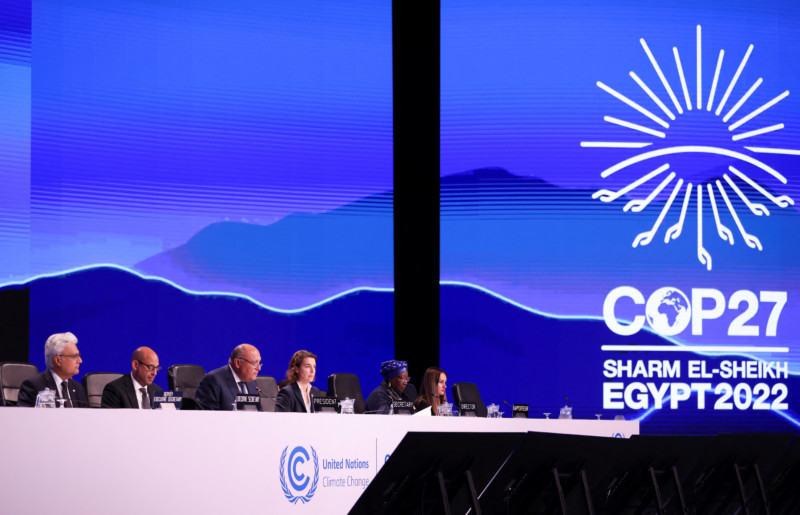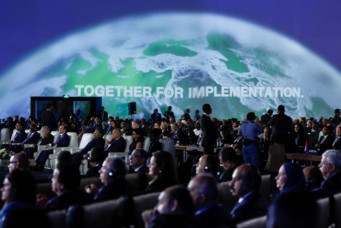When Consensus Is Reached
The outcome of the UN climate conference in Sharm El-Sheikh gives hope for climate justice, but leaves behind many challenges for the upcoming COP28 in Dubai

Ministers deliver closing statements at the COP27 climate summit in the Red Sea resort of Sharm El-Sheikh, Egypt, Nov. 20, 2022. Mohamed Abd El Ghany/Reuters
The conferences of the United Nations Framework Convention on Climate Change (UNFCCC) should be seen as a continuous annual process, and not as separate events. Only by analyzing the scope of the decisions adopted at previous conferences, and the content of the reports of the Intergovernmental Panel on Climate Change (IPCC) that warn about the challenges facing the international community in reducing the global threat of climate change and countries’ new issues of concern, can the result of each conference be objectively evaluated.
The Framework Convention was adopted in 1992 at the Earth Summit in Rio de Janeiro, Brazil. It entered into force in 1995, the year in which the first Conference of the Parties (COP) took place in Bonn, Germany. Today, it is the convention that has the greatest international acceptance, with the accession of 197 states, including the 193 UN member states, and some territories that have also committed to implement its provisions.
Each annual COP examines the state of international cooperation on climate change, the possibility of taking additional measures to reduce global greenhouse gas (GHG) emissions, or adaptation measures to climate change effects, and other international cooperation initiatives such as financing, capacity building, and technical cooperation, to support developing countries in reducing their emissions or enacting their own adaptation programs.
COP conferences are the only mechanisms available to the international community to reach agreements on reducing GHG emissions, and thus ward off the most serious threat faced by the international community as a whole: global climate change. The conferences are increasingly massive events in which thousands of people participate including delegates from national and subnational governments (regions and cities), representatives of international organizations, private sector and civil society organizations, experts, academics, activists, and media representatives. Discussions can be followed remotely by thousands of accredited people. More than forty thousand people were accredited at COP27 in Sharm El-Sheikh.
Decision-making is achieved through consensus but decisions are not adopted by the majority, which undoubtedly limits the possibilities of achieving significant progress with the speed required to tackle the most serious global threat facing humanity. However, when consensus is reached on a specific issue, it is more likely the corresponding decision will be applied by all states. In any case, COPs have no current substitute—the future of humanity and its survival as a species relies on their decisions.
A Global Threat
According to the latest IPCC report, global temperature rise is a scientifically proven fact and is occurring in all regions of the planet without exception, although in a differentiated way. Climate change caused by global warming is not uniform across geographic regions—there are areas and countries that are much more vulnerable than others. The IPCC estimates that global average temperatures are already 1.1 degrees Celsius above the 1850 pre-industrial levels. This rise in global temperatures has devastating consequences in many regions and countries around the world, causing prolonged droughts, catastrophic floods, the melting of the two poles, rising water levels and acidification of the seas, and an accelerated loss of terrestrial and maritime biodiversity. Climate change is also affecting food production in many countries. In 2022, large producers registered lower production than in previous years due to more acute and prolonged droughts. According to the World Food Programme, climate change puts 340 million people at risk of starvation in countries that have suffered a degree of food insecurity for years at a time. Moreover, climate change is producing new mass and disorderly migrations and violent conflicts in many countries.
According to the IPCC, a rise in average global temperature above 1.5 degrees Celsius could cause irreversible damage to the global climate system. Global GHG emissions must be radically reduced in the coming years of this decade: precisely, by 45 percent by 2030, using 2010 as a baseline.
The Main Achievements of COP27
The main challenge faced by COP27 in Sharm El-Sheikh was implementing the agreements reached in the previous six years, especially the Paris Agreement adopted at COP21 in Paris, and the so-called “Glasgow Package” approved in 2021 during COP26 in Glasgow.
It was expected that the most sensitive issue at COP27 would be related to the “loss and damage” suffered by poor nations, particularly those most vulnerable to climate change. The agreement to establish a special fund to help these countries cope with the consequences of global warming, such as terrible floods, intense heat waves, and prolonged droughts, was a positive outcome of COP27. Sadly, we know these climate phenomena do not come alone. They also bring with them the destruction of basic infrastructure, disruptions in food production, threats to the health of populations, and often generate violent conflicts that, in addition to the loss of lives, cause new waves of displaced persons and refugees. Although they might belatedly receive some climate justice, this new fund is a triumph for the large group of countries that have contributed least to climate change but are suffering its consequences the most. Their representatives returned home with the satisfaction that the international community had not completely abandoned them, and that they were able to show some results to both their governments and populations.
But in reality, establishing a fund like this is a sign that something very serious is happening. Its creation is necessary precisely because things are not going well. Instead of countries mitigating GHG emissions in recent decades, they have doubled them since 1990. If in the last thirty years the main GHG emitters had made a consistent effort in reducing them, these countries would not be creating tools to address the losses and damages they are causing.
Nevertheless, COP27 took important decisions on all items on its agenda, and three important acknowledgements stand out. Firstly, the recognition that to avoid irreversible damage in the global climate system and to keep the limit of temperature increase at 1.5 Celsius degrees, it is necessary to reduce global GHG emissions by 43 percent by 2030. Secondly, there was recognition of the need to double the funds for national adaptation plans in developing countries. Thirdly, the acknowledgement that developed countries have not fulfilled their commitment to annually mobilize one hundred billion dollars to help developing countries.
However, perhaps the most important COP27 agreement on financing was the understanding that about four trillion dollars is required to be invested annually in renewable energy until 2030 to achieve zero GHG emissions by 2050, and that the transition to a low-carbon economy will require an annual investment of between four and six trillion dollars. This implies the need to multiply private sector financing to help fund the sustainable transformation of our societies. Only by incorporating the private sector in all countries will it be possible to channel the enormous financial resources that this transformation requires.
The United Nations Environment Programme (UNEP) Report on the 2022 Emissions Gap shows that the world is still far from reaching the Paris Agreement target of limiting the rise of global average temperatures to a maximum of 1.5 degrees Celsius. According to the report, the policies of governments, mainly of G20 member countries, “point to a temperature increase of 2.8 degrees by the end of the century. Implementing current pledges will only reduce this to a temperature rise of 2.4-2.6 Celsius degrees by the end of the century.”
It is evident that there is strong resistance and competing interests that prevent environment-friendly structural changes from materializing to defeat climate change. As with the United States and Western Europe in the last century, today the main oil-producing countries and large transnational corporations defend the exploitation of fossil fuels, denying that these are mainly responsible for GHG emissions. Powerful political interests also exist in some high-emitting countries. The outcome of the 2022 U.S. midterm elections returned control of the House of Representatives to Republicans; their spokespeople have already announced that they will oppose the Biden administration’s efforts to accelerate the energy transition to renewable energy sources.
The 2022 UNEP report concluded that only an accelerated transformation of our societies can save us from the worst consequences of climate change. But this transformation cannot occur spontaneously. It is an indispensable condition that national governments assume a real commitment against climate change, adopting realistic plans to attract investments for renewable and non-polluting energies and sustainable projects.
Sustainable transformation requires the main GHG emitters—China, the United States, the European Union, India, and Japan—to make additional efforts to reduce their emissions, and to do so as soon as possible. For that reason, it is good news that China and the United States have resumed their dialogue on this matter, without which it would have been difficult to conceive that both nations could significantly reduce their emissions before 2030.
COP27 also invited all countries to continue making national efforts to reduce their GHG emissions during the present decade. There is hope that new technologies and increased financing can accelerate national mitigation plans among major emitters, most of which are part of the G20.
Another significant decision was the announcement by the UN Secretary-General which extended, over the next five years, an early warning network on climate disaster risks to the entire planet; this will help populations to develop their resilience through specific and timely strategies.
All in all, COP27 in Sharm El-Sheikh was a diplomatic success and holds out hope that over the next few years, until 2030, countries may make additional efforts to reduce their GHG emissions. It was a success because, for the first time, it provided international support to the least-developed and island developing countries for the loss and damage they are experiencing due to climate change. It should be stressed that these are the countries that have contributed the least to global warming.
The Challenges of COP28
The challenges facing COP28 in Dubai this November are enormous, however. Perhaps the most significant of these challenges will be for the conference to make the necessary decisions to operationalize the new loss and damage fund by 2024 to begin helping developing countries.
It will also be important for developed countries to demonstrate strong signs of intent to fulfill their commitment on resource mobilization. Beyond that commitment, it is essential to increase financial flows that facilitate the transformation of the global economy to a low-carbon one. Trillions of dollars are required, and funding is not flowing with the necessary speed.
The war in Ukraine dislocated global energy and food markets, further increasing food insecurity in many countries in North Africa and the Middle East. COP28 cannot make decisions on these issues except to emphasize that the global economy must start reducing its dependence on fossil fuels. A gradual and orderly reduction, one that does not unfairly punish the countries whose economies depend on the exports of these fuels, is necessary.
Along with increasing measures focused on emission mitigation, it is essential that national climate change adaptation plans be scaled up, particularly with realistic nature-based programs such as reforestation, extensive mangrove cultivation in coastal areas, and expansion of protected areas.
The ambition of Nationally Determined Contributions, especially of high-emitting countries, needs to be significantly increased. We will see if at COP28 some of these countries are willing to announce new goals.
All measures taken at the national, regional, and international levels require a significant increase in financial resources from the private sector toward green projects. Incentives must be increased for financial and non-finance institutions to raise their investments for the transformation of national economies into low-carbon economies. That will only happen if national governments make their commitment to sustainable transformation explicit in their national development strategies and plans for key sectors, especially energy, transportation, urban energy efficiency, and the food system.
It also requires a change in the practices of international development banks, especially the World Bank, the International Monetary Fund, regional banks, and financing funds for green projects. COP27 adopted a decision to request that all such entities review their procedures for providing timely concessional credit to developing countries.
In the medium and long-term, the only way to address climate change is through increased global awareness. This change implies a cultural, economic, and political transformation that leads countries to real changes in their patterns of production and consumption of all kinds of goods. Avoiding resource waste is essential. The war against nature is real and risks the survival of humanity on the only planet we can inhabit. We must learn to stop waging this war on nature that has led to a 69 percent average decline of wildlife populations since 1970. The Earth will adapt to climate change. It always has. But that adaptation could be done without us human beings.
The author gratefully acknowledges support from Shikha Bhasin, Prayank Jain, Nandini Harihar, Sumit Prasad, and Jhalak Aggarwal.
Miguel Ruiz Cabañas is Career Ambassador of the Mexican Foreign Service. He is currently the Director of the Initiative on the Sustainable Development Goals (SDGs) at the Tecnologico de Monterrey, Santa Fe, Mexico.
Read More




